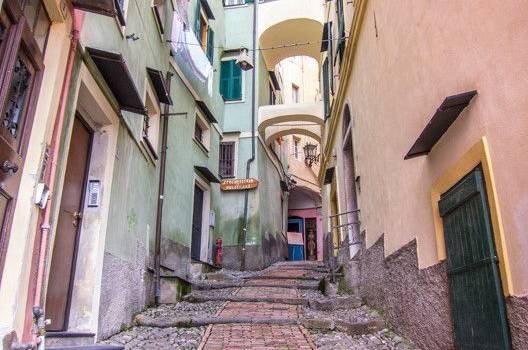The old town of Sanremo was founded in around XIth century and it was called the Pigna due to the design of its roads and fortifications that remind scails of a pinecone. The hamlet was enlarged and reinforced following that specific shape until the XVIth century, in order to help the citizens defend from the Moor pirates’ raids, more frequent since IXth century.
The visit on foot in the Pigna starts to XIVth cent. Saint Stephen arch in gothic style and dividing the new town from the old one.
1 Saint Stephen Arches
The set of Saint Stephen arches provide access to the Pigna following the road coming from the sea. The arches were created alongside of the defensive walls and each of them has been realized while building the different rings of walls during the enlargement of the town in the course of the centuries. Walking up from Piazza Cassini, the first door you meet dates back to the XVIth century and is linked on the left to a tower (today a dwelling place). This ring of walls was built to defend the town from the barbary pirates’ raids that swept the ligurian coastline throughout the XVIth century.
We then meet a late medieval door (XVth century) flanked by the typical houses in the Genoese style with some store-rooms protected by a series of porches. The last door is also the most ancient and comes with the first half of the XIV century ring of walls; on it we can see a marble plaque reading 1321 above an old city coat of arms in the middle and two other coats of arms belonging to Provençal or Neapolitan families (today almost totally ruined).
2 Dolori Square
In Square dei Dolori you can see the medieval coats of arms above the suggestive porches and a maze of alleys leading to the top of the Pigna. The square was connected to the Saint Stephen arch through the porches of Saint Sebastian, now closed. To the same saint it was dedicated an oratory, also called the Madonna dei Sette Dolori, situated under the porches. On the opposite side of the square, between the medieval buildings, stands the palace Gentile-Spìnola which was once the vacation home of the rich family of the mayor of the Republic of Genoa.
3 The oratory of Saint Sebastian
The oratory of Saint Sebastian, built in the XVI century, represents one of the most well preserved religious buildings in Sanremo. Situated in the picturesque Piazza dei Dolori, it was built after the Plague in 1502 in order to thank the Roman martyr who protected the city from the contamination. The entrance is protected by a porch, while the inside is decorated with frescoes of the XVIIth century, recently restored. It’s important to say that on the 18th of May 1538 Pope Paolo III prayed inside the church, before going to Manara’s in via Palma, where he was sheltered for the night. In the night of the 16th and 17th of April 1945 during WWII, the building was severely damaged, when the wooden buildings were set on fire.
4 Square and church of Saint Bridget
Square Saint Bridget is a wide area that the inhabitants use as a meeting place, street market and outdoor cinema in the summer. The homonym deconsecrated church is used as a cultural center and hosts various musical and cultural events.
5 San Costanzo’s Oratory
The building is what remains of the ancient Church of S. Pietro and Paolo destroyed by the earthquake in 1887. It still preserves the altar, an altarpiece painted by Domenico Piola and the organ.
Rebuilt in 1897 it was dedicated to the martyr Tebèo Costanzo, because who was said to preserve the people from fevers. Here we can find the relics of one of his arms and a jaw enclosed in a display case. In the oratory there is also the body of the holy warrior
Faustino, whom florists consider their protector.
6 Queen Elena’s GardensThe Gardens, located below the hill leading to the Sanctuary of the Madonna della Costa, were created in honor of Queen Elena of Montenegro, wife of King Vittorio Emanuele III, regular guest of Sanremo, the City of Flowers.
Il Park occupies a strategic position thanks to a panoramic view on the old Sanremo hamlet and the gulf.
This area has undergone considerable transformations since the mid-eighteenth century: it was partly occupied by buildings in front of the medieval castle demolished by the Genoese after Sanremo rebelled in 1753. The area was then rebuilt after the earthquake in 1887 and and was decorated with flower beds, trees and palm trees.
7 Sanctuary of Our Lady of the Coast
One of the most important places in Sanremo is the Sanctuary of Our Lady of the Coast. It is located in one of the most beautiful panoramic locations of the city. The baroque sanctuary dates back to 1630, while the dome dates back to the 18th century. The front is simple, with a shrine in which the Assunta is portrayed with the marble effigies of San Siro and San Romolo on the sides.
The construction was due to a sailor who, miraculously saved by pirates, opened a subscription to thank the Lady of the Coast, which was already famous for the
protection from the dangers of the sea.
The interior of the sanctuary is rich in marble decorations, stucco and in the following centuries it was embellished with numerous works of art. Of particular importance in the centre is a group of wooden statues by the Genoese sculptor Anton Maria Maragliano (1664-1741), representing Saint Joseph, Saint Joachim and Saint Anne, portrayed in veneration of the miraculous oval painting of Our Lady with the Child, surrounded by statues of angels. These three wooden statues, executed in 1735, were followed by those of Saint Zechariah and Saint Elizabeth, also by Maragliano, finished in 1737 and those of St John the Baptist and St John the Evangelist, both carved in 1735.
8 Cisterna Square
The water supply has always been a problem, and there are many tanks scattered in the underground of the ‘Cone’/Pigna of Sanremo, which recovered ground water or meteoric, when there wasn’t a public water system yet. The suggestive late medieval square of the Cistern, is an example of engineering acumen and urban wisdom that
has been able to compensate for the lack of water sources for centuries with a perfect system of rainwater collection and sorting: from the great cistern that is under the pavement of the square, channels of various capacities supplied in fact the smaller cisterns of the other districts. In the square there is the votive kiosk that represents the so-called ‘the Lady of Milk’, a very well-wishing figure that should have been painted around the end of the XVIIIth century.
9 San Giuseppe’s church
The church of seventeenth-century origin, but completed in the nineteenth century, is one of the most sumptuous of the village and reserves some curious surprises.
Between the rich decorations, the frescos, the statues, the marbles and the stuccos, there is no lack of valuable works of art, such as the high altar by the engineer Soli, the same that provided some of the city’s most elegant villas.
At the center of the presbytery, another stone altar, with decorations carved in bas-relief that resembles an ancient sarcophagus, is actually a trough for horses and mules, which the municipality had placed in 1928 at the railway station, where there was parking of the carriages.
In the Fifties the carriages disappeared, the Commune removed the trough and the parish priest of San Giuseppe decided to use it, in an original way, as an altar. Even the baptismal font next to the chapel on the right was a garden well. Also noteworthy is the hexagonal yellow marble tile near the confessional, which houses a fossil shell.
One side of the church is the Porta di San Giuseppe, still preserving the “caditoia”, that is an opening with three mouths, from which boiling oil was poured on the attackers in the Middle Ages. On one side of the door there is a small fountain surmounted by a huge stone pine cone, symbol of the village.
10 Manara’s
In the past, Palma Street was the main route of Pigna, and the houses of illustrious families overlooked it.
The Manara’s family house was considered the best in Sanremo and for this reason it had the privilege to host Pope Paolo III between the 17th and 18th of May in 1538. The Pope was going to Nice where he presented the truce between Carlo V and Francesco I. Paolo III-1534/1549 ( Alessandro Farnese), called the Council of Trento and approved the Jesuits’ rule.
11 Counts Sapia-Rossi Palace
Moving along Street Palma we can find Conti Sapia Rossi’s Palace in which the general Napoleon Bonaparte stayed in 1794. Actually, at that time Napoleon was just the Commander of the ”Artiglierie” of the French army. The General Andrew Massena guided the army and they crossed the border at Ventimiglia with 20.000 men to invade the territory of Genoa. On the occasion of this expedition, the General and Napoleon stopped in Sanremo on 7th September 1794 to have dinner in this Palace.
12 Saracena Tower
Saracena Tower is one of the most important monuments in Sanremo: it was used, in the XVIth century, for the city’s defense from the barbary corsairs’ attacks, which came from the Middle East and the North Africa. The construction of the tower dates back to the period between August and October 1550, when the communal authorities, following the multiplication of barbarian raids, decided to strengthen the city walls. Nowadays the tower is isolated from the Pigna’s district, and it presents a circular and slender form, while the interior is composed by a space with barrel vaults, probably used by the armed guard on occasions of the greatest danger.

